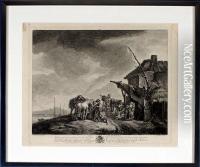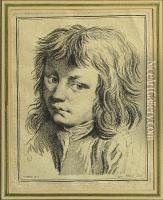Pierre Filloeul Paintings
Pierre Filloeul was a French engraver born in 1696. Despite not being as widely recognized as some of his contemporaries, Filloeul made significant contributions to the art world during the 18th century. His work primarily consisted of engravings, a form of printmaking that was highly popular during his lifetime. This technique involves incising a design onto a hard surface, such as copper or wood, by cutting grooves into it. The incised areas then hold ink, which, when pressed onto paper, transfers the design. Engraving was a crucial method for reproducing images before the advent of modern printing technologies.
Filloeul’s career spanned a period in French art history known as the Rococo era, characterized by its ornate and highly decorative style. This was a time when art moved away from the grandeur and strict regulations of the Baroque period to embrace more playful, light, and intricate designs. Engravers like Filloeul played a vital role in disseminating the works of painters and sculptors of the time, making art more accessible to the public. Through his engravings, Filloeul contributed to the spread of the Rococo style, capturing its essence and detail in his prints.
There is limited information available about Filloeul’s personal life or his training as an engraver. However, his surviving works suggest that he had mastered his craft with a high level of skill and precision. Filloeul's engravings often depicted scenes from mythology, religion, and everyday life, showcasing his versatility and attention to detail. His ability to translate these scenes into engravings demonstrates his keen eye for composition and his adeptness at capturing the nuances of human expression and the intricacies of natural and architectural elements.
Pierre Filloeul passed away in 1754, leaving behind a body of work that, while not as celebrated as some of his peers, remains an important part of the history of French engraving. His contributions to the art of engraving helped to document and propagate the artistic movements of his time, offering insight into the cultural and aesthetic preferences of 18th-century France. Today, Filloeul's engravings are studied by art historians and collectors who appreciate the technical skill and historical value they represent.

